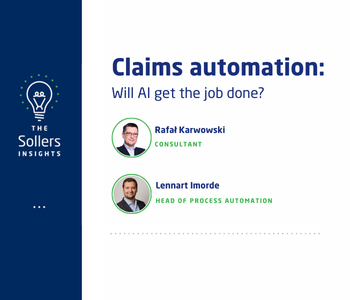
AI will have a significant impact on the insurance industry and will help to address operational challenges. Recent projects in the UK insurance industry, however, show how challenging it can be to automate with AI. Without a solid data foundation, even sophisticated technologies and skilled professionals will struggle to deliver meaningful results.
AI in Insurance Finance: Hype vs. Reality
The sudden rise of artificial intelligence has led many insurance companies to rush to implement AI-based solutions. Several use-cases have highlighted the importance of addressing fundamental requirements before getting started. One of the main challenges in a recent AI project in London was that data management could prove to be an obstacle. In our experience this is not an isolated issue in the insurance industry. Even well-prepared companies run the risk of underestimating the actual requirements of AI readiness.
Finance automation in the insurance industry is progressing, but it is still behind other areas, largely due to legacy systems and regulatory complexity. Insurers have begun to automate key processes such as accounts receivable and payable, expense management and financial reporting, but it is being done on a fragmented basis leading to inconsistent data quality and inefficiencies that undermine the full potential of automation.
An illustrative example of the challenges faced in implementing AI in finance automation comes from a series of projects undertaken by organisations in the UK insurance sector. These projects aimed to automate parts of their finance operations to improve efficiency and accelerate key business outcomes, such as improving cash flow through better debt management and optimising resource utilisation. At first glance, the combination of a suitable AI technology with a degree of human oversight seemed sufficient to streamline these workflows. The AI tool seemed to be promising, and all participants expected an easy transition to automation. However, real-life implementations quickly revealed that this approach was not sufficient.
Automation did not deliver the expected results
There were multiple objectives across the different projects, but they all shared a common overarching goal. It was to introduce partial or full automation of routine communication tasks triggered by specific account-related events and to apply AI models to improve the alignment of incoming financial data with existing records by using a combination of system information and supporting documentation.
Initially, it appeared that the right AI tools combined with a reasonable degree of human oversight would be sufficient to streamline several processes in this area. The technology seemed to be mature, and expectations were high for a smooth transition to automation. However, real-world implementation quickly revealed the limitations of this approach.
While the system architecture and AI logic were set up correctly, and human involvement was planned to handle exceptions, the automation often failed to deliver the expected results. Interestingly, the core problem was neither the AI algorithm nor the human input. The true obstacle was the data itself.
The initiatives uncovered a critical, often underestimated factor in finance automation: data quality and structure. The AI model struggled not because it lacked the intelligence to make matches, but because the input data was inconsistent, incomplete, or unstructured. Payment references did not follow a standard format, invoice numbers were missing or mismatched, making it difficult to create reliable automation rules.
The experience highlighted a key lesson in finance automation: having the right technology and human support is only part of the equation. Without clean, structured, and standardised data, even the most advanced AI solutions will underperform. The data management aspects of the business need to evolve into a standalone project, rather than being just a supporting component of the AI initiative.
Integration of technological innovation and human expertise
Data correctness and standardisation are the backbone of any successful automation initiative, so organisations need to prioritise data governance, harmonisation, and validation efforts alongside their investment in automation tools.
In summary, finance automation is a comprehensive effort. It’s about empowering finance teams with tools that increase efficiency, accuracy, and speed, but it also requires new skills, such as digital literacy, data analysis, and strategic thinking. The most successful automation efforts integrate technological innovation and human expertise, creating a smarter, more agile finance function. However, a critical component that often determines the success or failure of these efforts is the quality of the underlying data. Clean, well-structured, and consistent data is essential for finance automation to work properly and deliver reliable results. Without a solid data foundation, even the most sophisticated technology and skilled professionals will struggle to deliver meaningful results. Investing in data management and governance is therefore just as important as choosing the right tools or building the right team to enable successful finance automation.
Successful finance automation in insurance requires more than advanced AI and human oversight
— it depends on clean, consistent, and standardised data.
Without a solid data foundation, automation will underdeliver, making data governance and quality management just as critical as technology itself.
Authors of the article
 Małgorzata Kaczmarek - Business Specialist
Małgorzata Kaczmarek - Business Specialist



